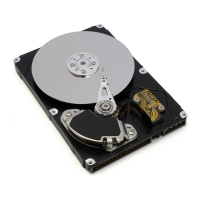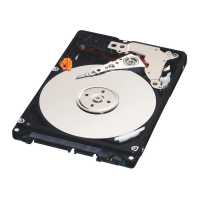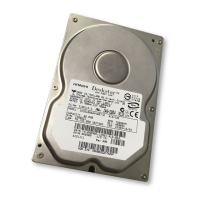Do you have a question about the Hitachi T7K250 - Deskstar - Hard Drive and is the answer not in the manual?
Introduces the document, lists references, and provides an abbreviation glossary.
Provides crucial warnings regarding force application, breathing holes, and ESD damage.
Explains the microprocessor and logic modules controlling drive operations.
Details the disks, actuator, spindle motor, and head positioning mechanism.
Lists default parameters like capacity, heads, cylinders, and sectors.
Contains mechanical positioning and transfer rate performance data.
Explains drive format and cylinder allocation strategies.
Details command overhead, seek times, head switch, and cylinder switch times.
Specifies various data transfer rates and throughput metrics.
Describes different operational states like Idle, Standby, and Sleep.
Shows the physical location of power and signal connectors on the drive.
Defines PATA and SATA interface signals, pin assignments, and voltage levels.
Specifies timing parameters for PIO, Multiword DMA, and Ultra DMA transfers.
Covers jumper configuration, temperature, humidity, and corrosion test requirements.
Details input voltage, power supply current, and reliability aspects like data integrity.
Provides dimensions, weight, mounting, and vibration/shock resistance data.
Covers safety approvals, flammability, handling, and EMC compliance standards.
Introduces the host interface and defines key terms used in the document.
Lists deviations from standard specifications for specific commands.
Provides a map of register addresses and their corresponding read/write functions.
Details registers like Alternate Status, Command, Cylinder High/Low, Data, Error, and Status.
Details device behavior for resets, diagnostics, and sector addressing modes.
Explains power management modes like Sleep, Standby, and Idle for reduced consumption.
Covers Self-Monitoring, Analysis, and Reporting Technology and device security features.
Lists commands for transferring data via Programmed I/O (PIO).
Details commands using Direct Memory Access (DMA) for efficient data transfer.
Describes commands for device configuration, identification, and diagnostics.
Covers commands for reading/writing data, buffer operations, and cache flushing.
Details commands for security features like disable password, erase unit, and freeze lock.
Explains commands related to Self-Monitoring, Analysis, and Reporting Technology functions.
Introduces the document, lists references, and provides an abbreviation glossary.
Provides crucial warnings regarding force application, breathing holes, and ESD damage.
Explains the microprocessor and logic modules controlling drive operations.
Details the disks, actuator, spindle motor, and head positioning mechanism.
Lists default parameters like capacity, heads, cylinders, and sectors.
Contains mechanical positioning and transfer rate performance data.
Explains drive format and cylinder allocation strategies.
Details command overhead, seek times, head switch, and cylinder switch times.
Specifies various data transfer rates and throughput metrics.
Describes different operational states like Idle, Standby, and Sleep.
Shows the physical location of power and signal connectors on the drive.
Defines PATA and SATA interface signals, pin assignments, and voltage levels.
Specifies timing parameters for PIO, Multiword DMA, and Ultra DMA transfers.
Covers jumper configuration, temperature, humidity, and corrosion test requirements.
Details input voltage, power supply current, and reliability aspects like data integrity.
Provides dimensions, weight, mounting, and vibration/shock resistance data.
Covers safety approvals, flammability, handling, and EMC compliance standards.
Introduces the host interface and defines key terms used in the document.
Lists deviations from standard specifications for specific commands.
Provides a map of register addresses and their corresponding read/write functions.
Details registers like Alternate Status, Command, Cylinder High/Low, Data, Error, and Status.
Details device behavior for resets, diagnostics, and sector addressing modes.
Explains power management modes like Sleep, Standby, and Idle for reduced consumption.
Covers Self-Monitoring, Analysis, and Reporting Technology and device security features.
Lists commands for transferring data via Programmed I/O (PIO).
Details commands using Direct Memory Access (DMA) for efficient data transfer.
Describes commands for device configuration, identification, and diagnostics.
Covers commands for reading/writing data, buffer operations, and cache flushing.
Details commands for security features like disable password, erase unit, and freeze lock.
Explains commands related to Self-Monitoring, Analysis, and Reporting Technology functions.
| Model | T7K250 |
|---|---|
| Brand | Hitachi |
| Type | Hard Drive |
| Capacity | 250 GB |
| Interface | SATA 3.0Gb/s |
| Cache | 8 MB |
| RPM | 7200 |
| Average Seek Time | 8.5 ms |
| Transfer Rate | 300 MB/s |
| Form Factor | 3.5-inch |











